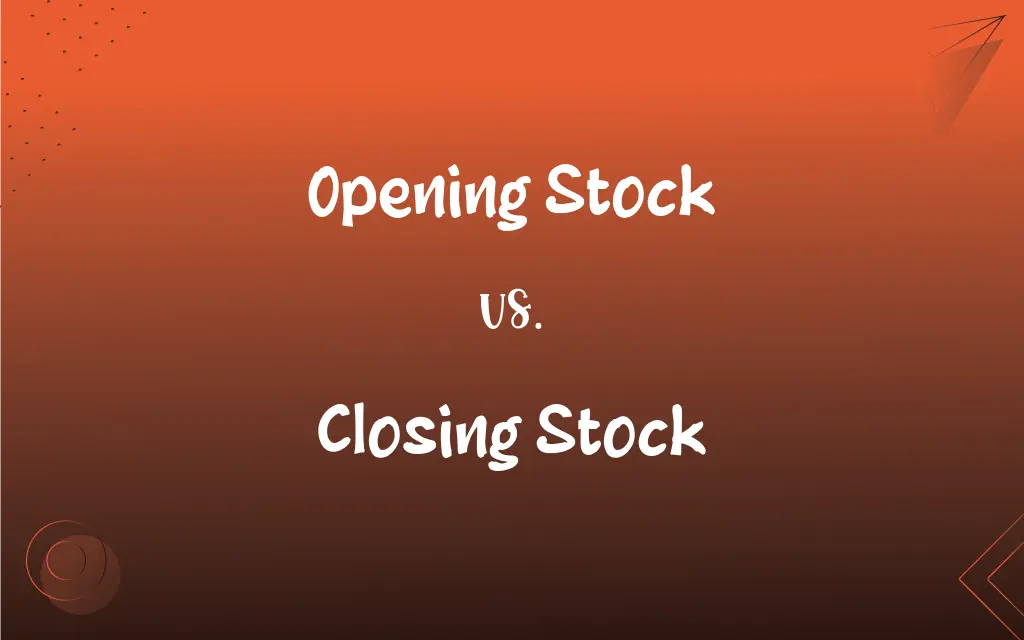Opening Stock vs. Closing Stock: What's the Difference?
Edited by Aimie Carlson || By Harlon Moss || Published on January 14, 2024
Opening stock is the inventory value at the start of an accounting period, while closing stock is the inventory value at the end of that period.

Key Differences
Opening stock refers to the value of inventory a business has at the beginning of an accounting period. This includes all types of goods available for sale. In contrast, closing stock represents the value of inventory remaining at the end of the accounting period.
The value of opening stock is carried over from the closing stock of the previous period. On the other hand, closing stock becomes the next period's opening stock, showing a continuity in inventory accounting.
Opening stock is essential for calculating the cost of goods sold (COGS) during an accounting period. Conversely, closing stock is important for determining the inventory level for the next period and is a critical component in calculating the gross profit.
To calculate the total inventory purchased during the period, businesses add purchases to opening stock and subtract closing stock. Whereas, the value of closing stock helps in understanding how much inventory is left unsold.
Opening stock is a starting point for inventory accounting in any period, while closing stock signifies the endpoint and is crucial for financial analysis and planning for the next period.
ADVERTISEMENT
Comparison Chart
Timing
Start of an accounting period
End of an accounting period
Role in COGS
Used to calculate the cost of goods sold
Used to determine remaining inventory value
Relation to Previous Period
Reflects the closing stock of the previous period
Becomes the opening stock for the next period
Purpose
To evaluate the initial inventory level
To assess the unsold inventory at period end
Impact on Financial Statements
Part of the initial assets calculation
Influential in calculating gross profit
ADVERTISEMENT
Opening Stock and Closing Stock Definitions
Opening Stock
The carry-over inventory from the end of the previous period.
Our opening stock was high due to last month's unsold items.
Closing Stock
A measure of unsold inventory at the period's end.
Our closing stock included a large number of overstocked items.
Opening Stock
The initial stock count used for calculating COGS.
Calculating COGS began with an opening stock of 200 units.
Closing Stock
The endpoint for inventory assessment in a given period.
The closing stock helped in finalizing the quarterly financial report.
Opening Stock
The inventory value at the beginning of a fiscal period.
The opening stock for the quarter was valued at $50,000.
Closing Stock
The final inventory value affecting the gross profit calculation.
A significant closing stock value affected the company's profit margins.
Opening Stock
The starting point for inventory tracking in a new period.
The opening stock set the baseline for this year's inventory management.
Closing Stock
The remaining stock that transitions into the next period's opening stock.
The closing stock will become next month's opening stock.
Opening Stock
The initial asset value in inventory at the period's start.
The company's opening stock included a diverse range of products.
Closing Stock
The inventory value at the end of a fiscal period.
The closing stock was estimated at $30,000.
FAQs
How is closing stock different from opening stock?
Closing stock is the inventory value at the end of the period, whereas opening stock is at the beginning.
Is opening stock an asset?
Yes, it's considered a current asset in accounting.
Why is opening stock important in accounting?
It's essential for calculating COGS and initial inventory levels.
What does closing stock indicate?
It indicates the unsold inventory and affects gross profit calculations.
How do you calculate opening stock?
It's usually the closing stock of the previous accounting period.
What factors affect closing stock value?
Sales, purchases, and inventory management during the period.
What is opening stock?
The value of inventory at the start of an accounting period.
Can opening stock value change during the period?
No, it remains constant for the entire period.
Does closing stock include work-in-progress?
It can include all forms of inventory, including work-in-progress.
What happens if opening stock is undervalued?
It can lead to an understatement of COGS and overstatement of profits.
How does closing stock impact liquidity?
High closing stock can tie up funds, affecting liquidity.
Should opening stock be the same as the previous closing stock?
Ideally, yes, unless there are adjustments like inventory write-offs.
Is closing stock carried forward?
Yes, it becomes the opening stock for the next period.
How is closing stock recorded in financial statements?
As an adjustment to the inventory account and in the balance sheet.
Does opening stock include raw materials?
Yes, if they are part of the inventory.
Is closing stock a measure of efficiency?
Yes, it can indicate inventory management efficiency.
Can opening stock be zero?
Yes, if a business is new or had no inventory at period start.
Can discrepancies in closing stock lead to financial issues?
Yes, it can lead to misstated financial statements and affect decision-making.
Can closing stock affect tax calculations?
Yes, as it impacts the profit and loss statement.
How do auditors verify opening stock?
By cross-checking with the previous period's closing stock records.
About Author
Written by
Harlon MossHarlon is a seasoned quality moderator and accomplished content writer for Difference Wiki. An alumnus of the prestigious University of California, he earned his degree in Computer Science. Leveraging his academic background, Harlon brings a meticulous and informed perspective to his work, ensuring content accuracy and excellence.
Edited by
Aimie CarlsonAimie Carlson, holding a master's degree in English literature, is a fervent English language enthusiast. She lends her writing talents to Difference Wiki, a prominent website that specializes in comparisons, offering readers insightful analyses that both captivate and inform.







































































